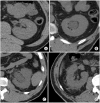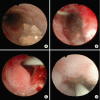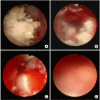Predictive Value of Preoperative Unenhanced Computed Tomography During Ureteroscopic Lithotripsy: A Single Institute's Experience
- PMID: 24255760
- PMCID: PMC3830971
- DOI: 10.4111/kju.2013.54.11.772
Predictive Value of Preoperative Unenhanced Computed Tomography During Ureteroscopic Lithotripsy: A Single Institute's Experience
Abstract
Purpose: Ureteroscopic stone removal is frequently used to remove ureteral stones. Mucosal edema and bleeding are the two most important obstacles to a successful operation. This study analyzed relationships between unenhanced computed tomography (UECT) findings and ureteroscopic findings to determine whether ureteroscopic results could be predicted preoperatively by using UECT imaging.
Materials and methods: From January 2009 to July 2011, 675 patients were diagnosed with ureteral stones through UECT. Among them, we retrospectively reviewed 92 cases of patients who underwent ureteroscopy (URS). We identified findings such as hydronephrosis, rim sign, periureteral fat stranding, and perinephric fat stranding on the UECT and then categorized these findings into four categories (none, mild, moderate, and severe) according to their severity. We also divided the URS findings of mucosal edema and bleeding into four categories (none, mild, moderate, and severe) and compared these findings with the UECT images.
Results: A total of 92 study patients were included in this study: 59 were male and 33 were female patients. According to the location of the stone, 31 cases were classified as upper ureteral stones, 15 were midureteral stones, and 46 were lower ureteral stones. Hydronephrosis identified with UECT was correlated with the mucosal edema severity observed during URS (p=0.004). The rim signs identified with UECT were proportional to the grade of mucosal edema (p=0.010).
Conclusions: Hydronephrosis and rim signs observed during UECT can be used as a predictive factor for intraoperative mucosal edema in patients undergoing URS.
Keywords: Ureteral calculi; Ureteroscopy; X-ray computed tomography.
Conflict of interest statement
The authors have nothing to disclose.
Figures



Similar articles
-
Secondary signs on preoperative CT as predictive factors for febrile urinary tract infection after ureteroscopic lithotripsy.BMC Urol. 2020 Aug 27;20(1):131. doi: 10.1186/s12894-020-00701-7. BMC Urol. 2020. PMID: 32854678 Free PMC article.
-
Factors that predict spontaneous passage of a small distal ureteral stone <5 mm.J Endourol. 2010 Oct;24(10):1681-5. doi: 10.1089/end.2010.0092. J Endourol. 2010. PMID: 20677988
-
Unenhanced helical CT of ureteral stones: incidence of associated urinary tract findings.AJR Am J Roentgenol. 1996 Jun;166(6):1319-22. doi: 10.2214/ajr.166.6.8633440. AJR Am J Roentgenol. 1996. PMID: 8633440
-
Minimally Invasive Surgical Ureterolithotomy Versus Ureteroscopic Lithotripsy for Large Ureteric Stones: A Systematic Review and Meta-analysis of the Literature.Eur Urol Focus. 2017 Dec;3(6):554-566. doi: 10.1016/j.euf.2017.04.006. Epub 2017 Apr 26. Eur Urol Focus. 2017. PMID: 28753887
-
Removal of ureteral stones with extracorporeal shock wave lithotripsy and ureteroscopic procedures. What can we learn from the literature in terms of results and treatment efforts?Urol Res. 2005 Jun;33(3):185-90. doi: 10.1007/s00240-005-0462-x. Epub 2005 May 29. Urol Res. 2005. PMID: 15924257 Review.
Cited by
-
Perirenal fat stranding as a predictor of disease progression after radical nephroureterectomy for renal pelvic urothelial carcinoma: a retrospective study.Discov Oncol. 2023 Jul 3;14(1):122. doi: 10.1007/s12672-023-00741-z. Discov Oncol. 2023. PMID: 37395929 Free PMC article.
-
Analysis of Clinical Characteristics, Radiological Predictors, Pathological Features, and Perioperative Outcomes Associated with Perinephric Fat Adhesion Degree.J Oncol. 2021 Dec 27;2021:9095469. doi: 10.1155/2021/9095469. eCollection 2021. J Oncol. 2021. PMID: 34987581 Free PMC article.
-
Analysis of predictors of adherent perinephric fat and its impact on perioperative outcomes in laparoscopic partial nephrectomy: a retrospective case-control study.World J Surg Oncol. 2021 Nov 4;19(1):319. doi: 10.1186/s12957-021-02429-6. World J Surg Oncol. 2021. PMID: 34732206 Free PMC article.
-
Association between incidental perirenal fat stranding on CT and metabolic syndrome in otherwise healthy adults.Radiol Med. 2024 Nov;129(11):1587-1596. doi: 10.1007/s11547-024-01888-7. Epub 2024 Sep 11. Radiol Med. 2024. PMID: 39259385
-
The mayo adhesive probability score predicts postoperative fever and sepsis in retrograde intrarenal surgery.Urolithiasis. 2024 May 31;52(1):80. doi: 10.1007/s00240-024-01586-z. Urolithiasis. 2024. PMID: 38819457 Free PMC article.
References
-
- Smith RC, Rosenfield AT, Choe KA, Essenmacher KR, Verga M, Glickman MG, et al. Acute flank pain: comparison of non-contrast-enhanced CT and intravenous urography. Radiology. 1995;194:789–794. - PubMed
-
- Dalrymple NC, Verga M, Anderson KR, Bove P, Covey AM, Rosenfield AT, et al. The value of unenhanced helical computerized tomography in the management of acute flank pain. J Urol. 1998;159:735–740. - PubMed
-
- Preminger GM, Tiselius HG, Assimos DG, Alken P, Buck C, Gallucci M, et al. 2007 guideline for the management of ureteral calculi. J Urol. 2007;178:2418–2434. - PubMed
-
- Abdelrahim AF, Abdelmaguid A, Abuzeid H, Amin M, Mousa el-S, Abdelrahim F. Rigid ureteroscopy for ureteral stones: factors associated with intraoperative adverse events. J Endourol. 2008;22:277–280. - PubMed
-
- Seitz C, Memarsadeghi M, Fajkovic H, Tanovic E. Secondary signs of non-enhanced CT prior to laser ureterolithotripsy: is treatment outcome predictable? J Endourol. 2008;22:415–418. - PubMed
LinkOut - more resources
Full Text Sources
Other Literature Sources

